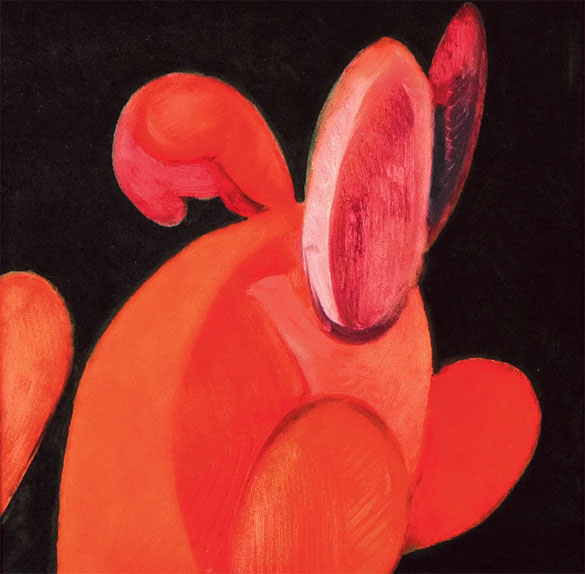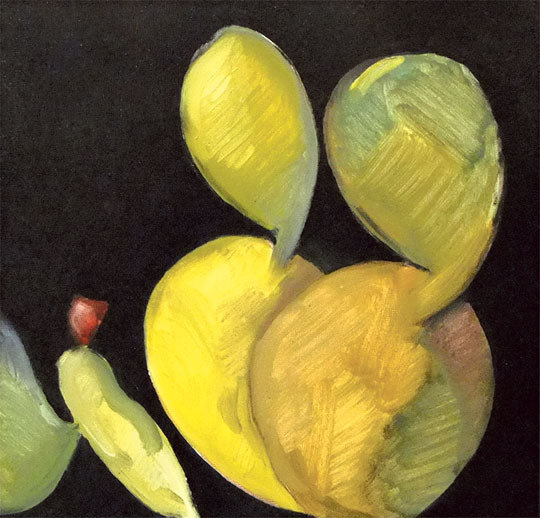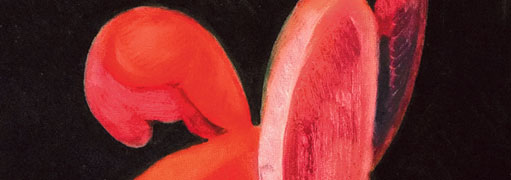Eason Eige has been painting the same subject for six years. Like many artists, he has expressed his fascination with, and perception of, his muse in series after series. But what makes Eige a bit different from the others is that his model isn’t a person. It’s a cactus. Specifically, it’s the prickly pear growing in front of San Felipe de Neri, the church in Old Town’s plaza. When the Alibi called to learn more about The Black Series , his upcoming show at the Bright Rain Gallery, Eige was at home, working on a painting he started in front of the church the day before.“I usually paint 12-inch panels,” he says, “and this is like three-by-three—9 square feet—which probably doesn’t seem like much to a lot of people, but to me it’s a big picture.” He’s been painting solely on square surfaces for more than a year, which he says he likes a lot. Experimenting with the shape and size of the art might help keep things fresh, but c’mon, Eige is still painting the same thing over and over. He explains how it stays engaging.By this point, he knows every inch of the plant well, he says. “It grows, and it blooms, and the pears come on and they bloom. The blooms go, and the pears turn purple, and then somebody comes along and cuts all the pears off.” His artist friends wonder why he’s still into it, but to him it’s bewitching. “The light changes, the air; it’s just a constantly interesting subject matter for me.”Repetition is key to Eige. “I’ve always painted in series,” he says. “Partly because you wake up in the morning and you’re not going have to think about, What should I paint today?” He says the process helps him cultivate discipline and learn more about his art form. “When you do something repeatedly, in different ways, you learn a lot about brushwork and color and composition, and all those things.”Each of Eige’s paintings is different, in part because he doesn’t stick to realism. His cacti are bold, colorful and sometimes otherworldly. “Color is one of the major interests for me,” he says, “I love extreme color.” He’ll see the green cactus and paint it bright orange or purple. He can’t explain why, he says, it just happens. Eige uses oils exclusively and talks about some of his favorite palette colors. Ultramarine blue and indigo make beautiful shadows, he says.The appeal of cacti lured Eige long before he moved to New Mexico. “Many years ago I was the director of an art center in Iowa and I had a little house,” he says. He filled his greenhouse with cacti and other succulents. “I would spend hours fooling around with them, looking at them, repotting them. I’ve been interested in cactus in general for a long time. I think it’s a weird, wonderful plant.”Although he primarily paints the Old Town cactus—he says it’s what he’s known for—Eige does branch out occasionally. “Last year I did a series of paintings of skulls, human-type skulls.” This year he has new verdant inspiration. He’s started a series called Ancient Plants. The first flora he painted was a lily. Eige says lilies and ferns—which are up next—are some of the Earth’s oldest plants. He was recently in Portland, Ore., and he snapped some photographs of the region’s ferns. He doesn’t normally work from photos, but there aren’t a lot of good ferns in New Mexico, he says. “The ferns that we have are pathetic. They look uncomfortable. They don’t look happy.”Losing his job in February upped his artistic productivity. “Every single day I paint,” he says, “and sometimes I get up in the middle of the night and paint. It’s crazy.” He has time to make up for. Eige was the senior curator at the Huntington Museum of Art in West Virginia for 20 years, and says he didn’t paint during the whole stint. Six years ago he picked it up again. “I could maybe consider trying painting as a job. It’s definitely a passion. I get up in the morning now and I’m glad to be alive. I don’t know how I had time to go to a job everyday.”
The Black Series
Opening Reception
Friday, July 1, 5 to 8 p.m.
Bright Rain Gallery
206 1/2 San Felipe NW
843-9176, brightraingallery.com












